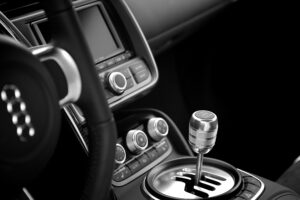Click or Press enter to Enter to Enable skip content option
Please Select a Section to Skip to

Driving a manual transmission, also called a stick shift, is a skill that not everyone has developed. With so many options in an automatic transmission, it’s not necessary to learn to drive manual. However, it can be a good ability to have if you ever need to drive someone else’s vehicle or if you want to widen your purchase options. Plus, it can be fun!
If you’re not familiar with the term, a manual transmission is a vehicle that requires the driver to time and switch gears to reach higher speeds. Moving from one speed to the next with the shifter makes the transmission move gears up or down. Manual vehicles come with a gear shift (the stick) in the center console and a clutch, which is next to the brake and is operated with the left foot.
A standard shifter comes with first, second, third, fourth and fifth gear, as well as reverse and neutral, which is simply moving the stick to the center of the shift tree, or the “H.”
There are three pedals with a manual transmission. Just like with an automatic, a manual vehicle will come with a gas and brake pedal. It also has a third pedal called the clutch. The clutch engages or releases the driveline to allow the transmission to switch gears. To use the clutch, you should press it all the way down to the floor with your left foot.
Once you’ve familiarized yourself with your setup, you’re ready to start moving. Press both the clutch and the brake down, then use the key to turn on the vehicle. Make sure that the shifter is in neutral (center of the H), which will allow you to idle until you’re prepared to move. Since manual vehicles don’t have a park (P) setting, the vehicle could roll if you don’t continue to press on the brake.
When you want to move forward, release the emergency brake, move the shifter from neutral to first gear, and slowly lift your foot off the clutch while easing down on the gas. If you don’t give the engine gas and only release the clutch the vehicle will stall.
As you get going, both your revolutions per minute (rpm) and your miles per hour (mph) will help you know when to shift up to the next gear. Here’s a basic breakdown of when to shift:
1st gear: 0-10 mph
2nd gear: 5-25 mph
3rd gear: 15-45 mph
4th gear: 30-65 mph
5th gear: 65+ mph
This will be the same for deceleration. You will need to downshift, moving through the gears in reverse order as you slow.
Depending on the situation, you might not need to go into reverse or press the gas at all to back up. If you’re on an incline, you might only need to put the car in neutral or start to release the break for it to start to roll backwards. When parking, be sure to set the shifter back into neutral and to set the emergency break. Again, there is no P setting here, so the emergency break will make sure your car stays put.
It will take time and practice to become a proficient manual vehicle driver. Don’t give up! Once you learn you will be able to drive any vehicle, which might open your possibilities when considering a vehicle purchase or in any situation when a manual is the best option.
Want to own a manual? Contact the dealerships at Ontario Auto Center to learn more about the available options.
While great effort is made to ensure the accuracy of the information on this site, errors can occur. Please verify all pricing information with a customer service representative. This is easily done by calling us or visiting us at the dealership.
Customer may not qualify for ALL Rebates shown. Some rebates are stackable and others can and cannot be combined. See Dealer For Complete Details.